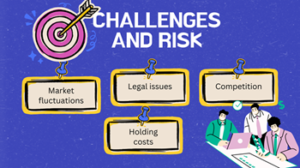What is Domain Flipping?
Domain flipping is the process of buying a domain name with the intention of selling it at a higher price later, many times company or individual who wants to use it for their business or brand.

Steps involved in domain flipping:
- Research: Find valuable domain names using tools like keyword research software, domain name generators, and auction listings.
- Registration: Register the domain name at a registrar like GoDaddy or Namecheap.
- Holding: Hold the domain for a period, waiting for the right buyer.
- Listing: List the domain for sale on marketplaces like Sedo, Uniregistry, or Afternic.
- Marketing: Promote the domain through social media, email marketing, or paid advertising.
- Negotiation: Negotiate the sale price with potential buyers.
- Transfer: Transfer the domain to the buyer after payment.
Types of domain flipping?
- Hand registering: For the purpose of domain flipping register new domain.
- Expiring domain flipping: Buying domains that are expiring or have expired.
- Auction flipping: Buying domains at auction and reselling for a profit.
- Portfolio flipping: Buying and holding a portfolio of domains, then selling the entire portfolio.
- Drop catching: Registering domains that have been dropped by their previous owners.
- Domain name trading: Buying and selling domains like stocks, with a focus on short-term profit.
- Domain parking: Registering domains and parking them with advertising, then selling the domain and its associated revenue stream.
- Domain leasing: Leasing domains to businesses or individuals, then selling the domain.
- Brandable domain flipping: Buying and selling brandable domains, often with a focus on startups.
- Keyword domain flipping: Buying and selling domains with high-value keywords.
- Geo-domain flipping: Buying and selling domains related to geographic locations.
- Premium domain flipping: Buying and selling high-value, premium domains.
Challenges and risks?
- Market fluctuations: When there will be fluctuations in the market then automatically domain Domain values decrease.
- Legal issues: Due to domain disputes you may have to face legal issues.
- Competition: There is a lot of competitions because any flippers compete for the same names.
- Holding costs: In this market annual registration fees and potential renewal costs.
Benefits of Domain Flipping?
-
High Profit Potential
Scalability: In particular, Domain flipping can yield substantial returns, especially if you acquire domains at low prices and sell them for a significant profit. Some domain flippers have turned modest investments into thousands or even millions of dollars.
Low Initial Investment: Compared to other forms of investment, domain flipping can be started with a relatively small budget, making it accessible to a wide range of people.
-
Flexibility
Work from Anywhere: Domain flipping is an online business, allowing you to work from anywhere with an internet connection. This flexibility is ideal for those looking for location independence.
Flexible Schedule: You can engage in domain flipping part-time or full-time, depending on your availability and financial goals.
-
Growing Market
Increasing Demand: As more businesses and individuals establish an online presence, the demand for good domain names continues to grow. This trend creates ongoing opportunities for domain flippers.
Global Reach: The market for domains is global, allowing you to buy and sell domains with people from all over the world.
-
Minimal Overhead Costs
Low Maintenance: Domains require minimal upkeep compared to physical properties or other assets. The primary costs are domain registration fees and potentially renewal fees.
No Physical Inventory: Since domains are digital assets, there’s no need to manage or store physical inventory, reducing operational complexities.
-
Portfolio Diversification
Investment Diversification: Domain flipping can be a valuable addition to an investment portfolio, providing diversification alongside other assets like stocks, real estate, or cryptocurrency.
Passive Income Potential: Some domain flippers earn passive income by parking domains, where ads are placed on the do
main’s landing page, generating revenue from clicks
-
Learning and Skill Development
SEO and Marketing Knowledge: Successful domain flipping requires knowledge of SEO, digital marketing, and industry trends.
Negotiation and Sales Skills: Domain flipping involves negotiating deals and marketing domains, helping you develop important business skills.
-
Opportunity to Help Businesses
Assisting Startups: By acquiring and selling relevant domains, you can help startups and businesses establish their online identity, which is crucial for their success.
Brand Building: Flipping brandable domains can contribute to the branding efforts of companies, making it a rewarding aspect of the business.
-
Exit Strategy
Easy Liquidation: Unlike physical assets, domains can be quickly listed and sold on various marketplaces, providing an easier exit strategy if you need to liquidate your investments.
Tools and resources?
- Domain name registrars: GoDaddy, Namecheap, Google Domains
- Domain marketplaces: Sedo, Uniregistry, Afternic
- Keyword research tools: Google Keyword Planner, SEMrush
- Domain valuation tools: Estibot, DomainIQ

What is Domain flipping strategies?
-
Market Research
Identify Trends: Keep an eye on emerging industries, technologies, and keywords. Use tools like Google Trends and Ahrefs to spot trending topics.
Analyse Sales Data: Study past domain sales on platforms like NameBio to understand what types of domains are selling and for how much.
Focus on Niche Markets: Target specific niches where you have knowledge or see potential growth. Niche domains can often sell for a premium.
Right Domain Extensions: While .com is king, other extensions like .net, .io, and .ai are also valuable in specific niches.
Short and Memorable: Short, brandable domains are more likely to sell. Aim for domains that are easy to spell and remember.
Keyword-Rich Domains: Include relevant keywords in your domain avoid making the domain too long.
-
Valuation
Use Valuation Tools: Leverage tools like EstiBot, GoDaddy Appraisal, and Sedo to get a rough estimate of your domain’s value.
Consider Market Factors: Assess the domain’s potential based on market demand, the competitiveness of the niche, and comparable sales.
-
Acquisition
Buy Expired Domains: To being with ,use tools like Expired Domains.net to find domain that have recently expired but still hold value.
Participate in Auctions: Bid on domains through platforms like GoDaddy Auctions and Name Jet to acquire valuable domains at potentially lower prices.
Direct Outreach: If you identify a domain you want, consider reaching out directly to the owner with a purchase offer.
-
Enhance Domain Value
Develop the Domain: Even a simple landing page with basic content can increase a domain’s value. Consider adding SEO-friendly content or setting up a small website.
Improve Domain Authority: If possible, build backlinks to the domain to increase its SEO value, making it more attractive to potential buyers.
-
Sales Strategy
List on Multiple Marketplaces: Sell your domain on platforms like Sedo, Flippa, GoDaddy Auctions, and Afternic to reach a broader audience.
Set a Competitive Price: Price your domain based on its appraised value and market demand. Consider setting a “Buy Now” price for quick sales.
Negotiate Wisely: Be prepared to negotiate. Being that minimum acceptable price in mind, but be flexible to close the deal.
- Legal Consideration
- Scaling the Business
- Exit Strategy
Common mistakes to avoid?
- Registering low-quality domains: Domains with hyphens, numbers, or excessive length can be harder to sell.
- Overpaying for domains: Be cautious of overpriced domains or auctions with high bidding.
- Not researching trademarks: Ensure the domain doesn’t infringe on existing trademarks.
- Not having a sales strategy: Plan how you’ll market and sell your domains.
